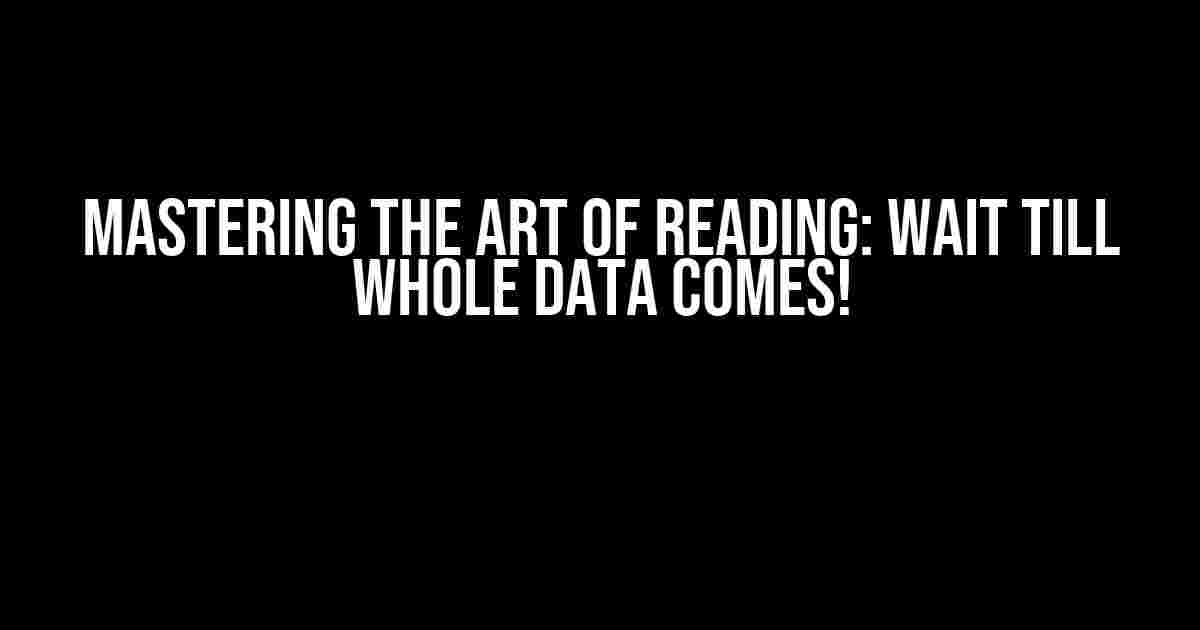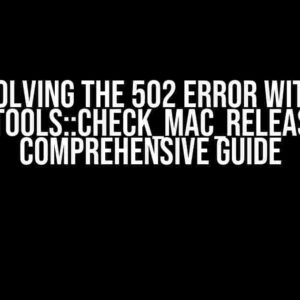Are you tired of dealing with incomplete data? Do you find yourself wondering what’s missing from your reads? Well, wonder no more! In this comprehensive guide, we’ll dive into the world of reading and explore the importance of waiting till whole data comes. Buckle up, folks, and get ready to level up your reading game!
What is Read() and Why is it Important?
The Read() function is a fundamental concept in programming, allowing you to retrieve data from various sources, such as files, networks, or databases. It’s a crucial step in data processing, analysis, and decision-making. However, it’s not uncommon to encounter issues with incomplete or partial data, leading to errors, inaccuracies, and frustration.
The Problem with Partial Data
Partial data can be detrimental to your project’s success. Here are just a few reasons why:
- Inaccurate Results: Incomplete data leads to inaccurate results, which can have serious consequences in fields like finance, healthcare, or aviation.
- Wasted Resources: Processing partial data can be a waste of time, computational resources, and energy.
- Frustration and Delays: Dealing with incomplete data can cause project delays, leading to missed deadlines and frustrated team members.
The Solution: Wait Till Whole Data Comes!
So, how do you avoid these problems? The answer is simple: wait till whole data comes! This approach ensures that you receive complete and accurate data, every time. Here’s how:
Using Read() with Blocking
One way to wait till whole data comes is by using the Read() function with blocking. This approach involves waiting for the entire data to be received before processing it.
// C# example
using System.IO;
FileStream fileStream = new FileStream("data.txt", FileMode.Open);
byte[] buffer = new byte[fileStream.Length];
// Wait till whole data comes
fileStream.Read(buffer, 0, buffer.Length);
// Process the complete data
ProcessData(buffer);
Implementing a Read() Loop
Another approach is to implement a Read() loop that continues until the entire data is received. This method is particularly useful when dealing with large files or networks.
// Java example
import java.io.FileInputStream;
import java.io.IOException;
FileInputStream fileInputStream = new FileInputStream("data.txt");
byte[] buffer = new byte[1024];
int bytesRead;
// Read() loop
while ((bytesRead = fileInputStream.read(buffer)) != -1) {
// Process the received data
ProcessData(buffer, bytesRead);
}
Using Asynchronous I/O
Asynchronous I/O is a more efficient approach that allows you to handle other tasks while waiting for the data to arrive. This method is ideal for real-time applications or scenarios where responsiveness is crucial.
// Node.js example
const fs = require('fs');
fs.readFile('data.txt', (err, data) => {
if (err) {
console.error(err);
return;
}
// Process the complete data
ProcessData(data);
});
Best Practices for Waiting Till Whole Data Comes
To ensure successful implementation of the “wait till whole data comes” approach, follow these best practices:
- Choose the Right API: Select an API that supports your programming language and provides a reliable Read() function.
- Set Appropriate Buffer Sizes: Allocate sufficient buffer space to accommodate the expected data size.
- Handle Errors and Exceptions: Implement robust error handling to deal with unexpected errors or partial data.
- Monitor Progress: Use progress indicators or logging to track the data reception process and identify potential issues.
- Test Thoroughly: Perform extensive testing to ensure that your implementation works correctly under various scenarios.
Common Pitfalls to Avoid
When implementing the “wait till whole data comes” approach, be mindful of the following common pitfalls:
| Pitfall | Description |
|---|---|
| Incorrect Buffer Allocation | Failing to allocate sufficient buffer space can lead to data loss or corruption. |
| Ignoring Error Handling | Neglecting to handle errors and exceptions can result in data loss, crashes, or unexpected behavior. |
| Inadequate Testing | Insufficient testing can lead to undetected bugs, causing data corruption or processing issues. |
| Assuming Data Completeness | Falsely assuming that the data is complete can result in inaccurate results or processing errors. |
Conclusion
In conclusion, waiting till whole data comes is a crucial aspect of reading data correctly. By understanding the importance of complete data, implementing the right Read() function, and following best practices, you can ensure accurate results, reduce errors, and optimize your project’s success. Remember, patience is a virtue, especially when it comes to reading data!
So, go ahead, take the “wait till whole data comes” approach, and watch your projects thrive! If you have any questions or need further guidance, please don’t hesitate to ask. Happy coding!
Frequently Asked Question
Get the scoop on “Read() wait till whole data came” and clear up any confusion!
Why do I need to wait for all the data to arrive before reading?
Waiting for all the data to arrive ensures that you receive the complete and accurate information. If you start reading before the data is fully transmitted, you might miss crucial parts or receive corrupted data, leading to errors or inconsistent results.
Will my program hang or timeout if I wait for all the data to arrive?
It’s possible, but there are ways to mitigate this. You can set a timeout value to limit the waiting period, or use asynchronous I/O operations to avoid blocking your program. Additionally, you can implement retry mechanisms to handle cases where the data transmission is interrupted or slow.
How do I know when all the data has arrived?
You can use various methods to determine when all the data has arrived, such as checking the file size, monitoring the transmission progress, or using message framing techniques. In some cases, the sender might send a special “end-of-transmission” signal or a checksum to indicate the completion of data transfer.
What happens if I read the data in chunks instead of waiting for the whole thing?
Reading data in chunks can be useful for processing large datasets, but you’ll need to handle the complexity of buffering, parsing, and reassembling the data. Be cautious, as this approach can lead to errors if the chunk boundaries don’t align with the underlying data structure or format.
Are there any performance implications from waiting for all the data to arrive?
Yes, waiting for all the data to arrive can introduce latency and impact performance, especially for large datasets or slow network connections. However, the trade-off is often worth it, as it ensures data integrity and accuracy. To mitigate performance issues, consider using parallel processing, caching, or optimizing your I/O operations.


